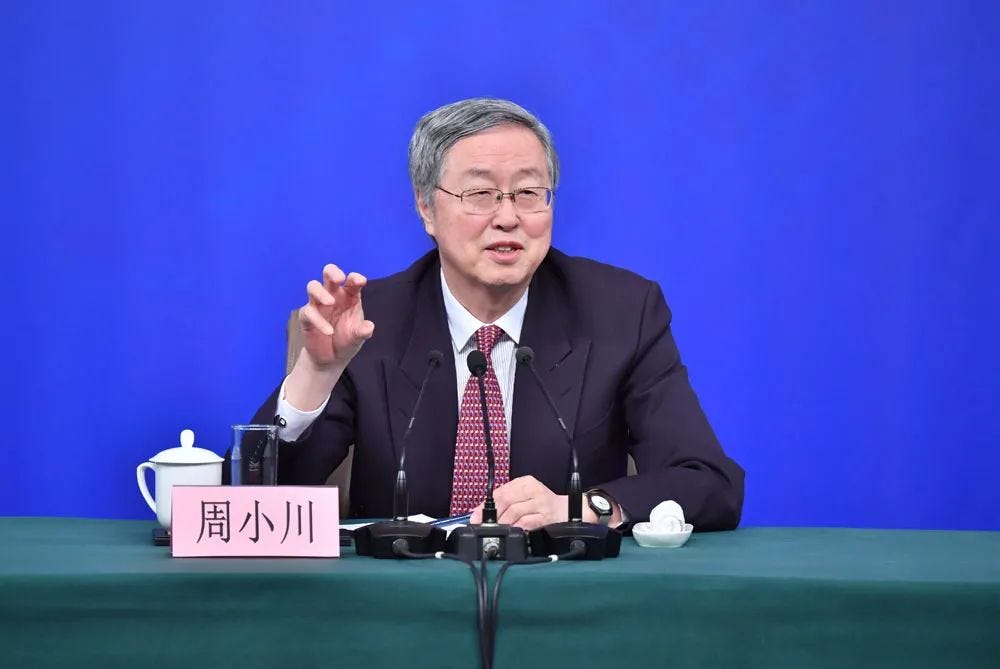Is China Getting Comfortable With Bitcoin?
A panel discussion on Sunday between two central bank officials in China indicates that the country may be softening its hardline opposition toward Bitcoin and cryptocurrencies. Da bing digs in.
Hi, I’m Shuyao Kong 孔姝尧. Da bing is my weekly rumination of worthwhile news happening in China’s crypto ecosystem.
If culture is capable of anything, then it is finding that which unites us all.
Meme of the Week
Two weeks ago, Peter Thiel accused China of using Bitcoin as a financial weapon. This week, Xiaochuan Zhou and Bo Li, ex-governor and current deputy governor of the Central Bank of China respectively, after years of silence on Bitcoin, voiced their views on Bitcoin, the king of crypto.
Who knows how much Thiel’s argument led the Chinese government to re-evaluate its stance on digital assets? But that the government is more prone to talk about the matter at all, shows that they are more receptive to rethinking their antagonistic stance to crypto.
This week’s da bing digs beneath the political jargon, digests the Central Bankers’ conversation, and tries to understand whether this is simply a friendly conversation among friends—or, a major bullish change in China’s perception of crypto.
Crypto as an “alternative investment”
Crypto operates in a grey zone in China. Over the years, it has figured out how to stay on the correct side of the red line that cordons off sensitive topics, such as capital outflow and internet gambling. Just look at Huobi and OKEx: Both operate an exchange business in a country that has banned ICOs and exchanges since 2017.
On April 18, both Zhou and Li participated on a panel discussing “Digital Payment and Digital Currency,” during which the moderator asked Li whether China will maintain an “iron wrist (铁手腕)” attitude toward crypto trading, Li, like the Central Banker he is, did not directly answer the question, which is significant.
Instead, he called for more regulation. However, one point he made especially (and almost shockingly) clear was that Bitcoin specifically, and crypto in general, ought to be recognized as an “alternative investment vehicle.”
“Both Bitcoin and stablecoins are crypto assets,” and therefore ”are not currencies,” Li said. In other words, don’t treat this stuff like it’s money. It’s an investment class and “therefore should be regulated as an asset class,” he said, adding however that this “will not change the way we regulate it for now.”
Compared to the past few years when the government was reluctant to even mention Bitcoin and other crypto assets, this conference brought crypto to the forefront and gave the central bankers a platform to tell the world that it cares, too.
Crypto serving the real economy
Zhou, despite having left his job two years ago as the governor of the Central Bank, carries more authority among the two leaders. He emphasized that digital assets don’t directly benefit the Chinese economy as much as digital currency, because the former seems to be more of a financial game, while the later actually serves the real economy.
Interestingly, his tone was cautious—not pessimistic.
Zhou said: “Just like the financial crisis more than a decade ago, crypto could become a game between large financial institutions and end up having nothing to do with the real economy.”
Perhaps Zhou has studied yield farming like many of us and understands how crypto is still in the stage of recycling tokens from one farm to another? Regardless, his point was crystal clear: Not all digital assets are created equal, and those that serve as a speculative tool must be regulated—and punished, if done illegally.
Stablecoins should be regulated as a bank
Li singled out stablecoins as a subset of digital assets. He noted that most stablecoins have real-world applications, such as payments, that could touch the lives of many. If they become more integrated with the economy, there has to be more stringent regulation.
Zhou has clearly done his stablecoin research and mentioned that stablecoins issued by private companies should be regulated in the same way as banks. Does that mean USDC could one day enter China and be regulated as a bank-grade financial institution? Obviously, he did not go there.
Regulating stablecoins? Not banning them outright? That this was even on the table was surprising. I had thought that the government would ban any token that it hadn’t sanctified and launched. But seeing that they are open to the idea, rigorous regulations aside, makes me think that the government is considering testing what stablecoins can do for the economy.
The digital yuan
Lastly, the conversation could not finish without talking about China’s digital yuan. As the government increases its circulation, DCEP is poised to be China's largest financial infrastructure roll out in 30 years.
To echo the Digital Yuan’s philosophy, Zhou emphasized that “it doesn’t matter whether one is using digital assets or digital currency in their digital wallet. Most citizens don’t understand the backend complications and don’t care about decentralization either.”
Every citizen needs to know that they cannot use the new digital money to launder money, evade taxes, purchase weapons, or gamble. In this way, it is like the U.S., too.
Bullish or just shooting the bull?
Even though the conversation appeared to be just a chat and the two Central Bankers were measured in their choice of words, the fact that they could openly discuss Bitcoin as an asset class and semi-show off their knowledge of stablecoins tells the world that China is thinking beyond its digital yuan.
It has always been keeping a close eye on the juicy stuff, especially now that Coinbase has gone public and many public-listed companies, such as Tesla, are buying into the asset class. The Chinese government simply cannot lag too far behind.
So let’s treat this conversation more as a somewhat snide response—“Thank you Peter Thiel for the show of love! Rest assured that we are closely monitoring the situation.”—than a specific, concrete policy change.
China is not sleeping through the crypto revolution. The fact that this conversation happened in public and raised a number of interesting questions in a fairly open way, showed that the government is still trying to get a handle on crypto. The current ban notwithstanding, crypto and how China deals with it, is very much a work in progress.
Do you know?
“凡尔赛” which means “Versailles” in Chinese, is a recent buzz word that describes someone who wants to show off, but tries not to show off too explicitly. It’s someone who really wants to brag about being rich and educated, but the only way to do so is to brag about going to Versailles. In Chinese crypto, many use the word to humble brag their bag. Like, “Gee, I only was hodling DOGE so I missed the BTC crash.”
China-based Metaverse Labs organized the first online/offline exhibition on Decentraland
The initiative brought a breeze of fresh air to China’s recent NFT buzz. Compared to the others that sell random jpeg files, Metaverse, the DAO behind the initiative, is an ambitious city-builder on Decentraland. It’s conducted field research and aspires to be as accurate as possible. This time, they are bringing the initiative to the real world by collaborating with the China Academy of Arts, the best art institute in China.
Who doesn’t want to see China from 80 years ago on a piece of virtual land? Especially for those who are still prohibited from real-world traveling!
Xinjiang’s mining accident drags Bitcoin hashrate down by 21.5%
A coal mine accident in Xinjiang has reportedly sent Bitcoin’s hashrate down by an order of magnitude. Specifically, Antpool has gone down by 24.5%, BTC.com down by 18.9%, and Poolin is down by 33%. Since the government has shut down electric utilities in a few key counties, these mining farms are forced to shut down too.
For many, this is another perfect example of Bitcoin’s reliance on China—but others beg to differ.
The crypto media site Wu Blockchain quoted a spokesman for a big mining and crypto financial institution and reported “Xinjiang has dropped by 20%, indicating China's Bitcoin hashrate may already be less than 50%.” The logic is that Xinjiang controls more than 50% of China’s hashrate. If Xinjiang is down and the global hashrate is down by 21.5%, then China’s overall hashrate could be less than 50%, which supports the theory that bitcoin mining is moving from the east to the west.
China’s crypto community pulse check
Very few crypto articles could evoke as much sentimentality as Yang Li’s blog “Orangefans” (橙皮书).
In his latest article, Yang recounted the past four years of how crypto has evolved (or rather, staggered) in China. His sentiments were largely triggered by Coinbase’s IPO, which asks every Chinese crypto builder a soul-crushing question: Why have we failed to build our own Coinbase equivalent?
Perhaps one could blame the regulatory environment. But that’s not the full picture. During the past 3 years of a bear market, China took a purely speculative stance on crypto innovation. Rarely have we seen entrepreneurs that are as dedicated to building as Hayden Adams from Uniswap for example.
We’ve lost ground in China, but at least, “we should stop being the ostrich that buries its head in the sand” and look at how to reclaim the lost territory.






